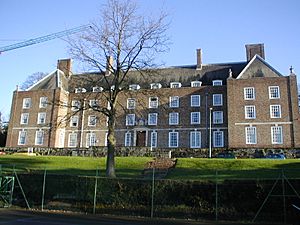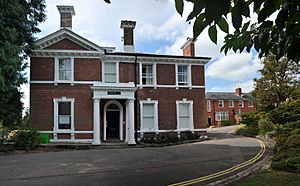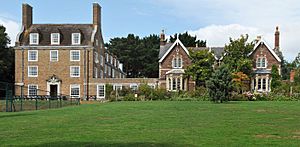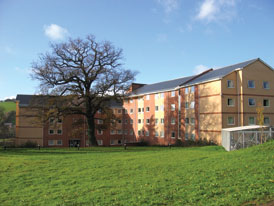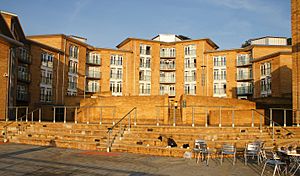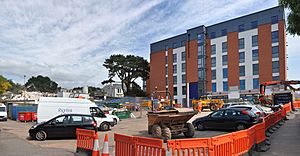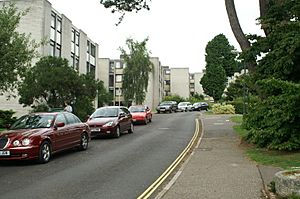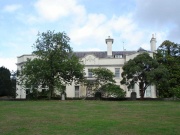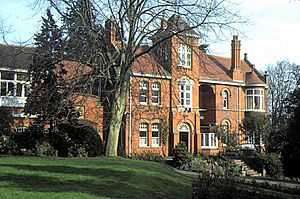University of Exeter Halls of Residence facts for kids
The University of Exeter has about 5,900 special rooms for its students to live in. Most of these homes are right on the main campus. However, about 30% of the homes where students cook for themselves are located off-campus, especially for the St Luke's Campus.
The very first places for students to live were in the city centre in the early 1900s. The first building made just for students was Mardon Hall, which opened in 1933.
Contents
Early Student Homes
The university grew from the Royal Albert Memorial College in the 1800s. By 1902, it was clear that female students needed places to stay. A house on Castle Street was used as a hostel for them. In 1906, the city council bought this house, made it bigger, and called it Bradninch Hall. It could house 78 female students and was the college's first official student home.
During the First World War, Bradninch Hall became a hospital. Students moved to Hartwell House and two houses on Pennsylvania Road. After being made bigger in the 1920s, Hartwell House became Hope Hall. The Pennsylvania Road houses became Kilmorie Hall.
In 1902, two houses on St. David's Hill were rented for female students. This place, called Sandford Hall, was used by the university college for two years from 1946. In 1904, the college rented a field called Grâs Lawn. The college bought this field in 1912, hoping to build a home for male students there. But this never happened, and the land was sold in 1999.
In the early 1920s, Reed Hall and two houses on Grendon Road were bought for male students. Today, Reed Hall is used for weddings and conferences.
Exeter Halls
The Exeter Halls are located on the Streatham Campus. They include Hope Hall, Lopes Hall, Kilmorie Hall, Pennsylvania Court, Ransom Pickard, Lazenby, and their smaller buildings. James Owen Court is also part of Exeter Halls, but it's for students who cook for themselves. About 700 students live in Exeter Halls.
These halls are very popular. On average, three students apply for every one spot! The students living in Exeter Halls have a committee that plans events, including a big Summer Ball.
Hope Hall
Hope Hall used to house about 60 students in three converted family homes. It first opened in 1915 as a home for girls and was called Hartwell House. In 1925, it was reopened and renamed Hope Hall. This was done by the Duke and Duchess of York, to thank Helena Hope for her kind donations. A painting of Helena Hope is in the main entrance. Even Queen Mary visited the hall in 1938.
Hope Hall has beautiful grounds near Lazenby, which housed about 18 students. Both buildings have cool old features like original fireplaces and antique decorations.
Hope Hall had a TV room, laundry, and a bar called 'The Badger'. It used to serve meals, and its smaller buildings like Lazenby and Byrne House (now offices) ate there. Now, the dining room is a social space, often used by dance groups.
In 2013, Hope Hall and Lazenby were updated to create more office and research spaces for university staff. The Badger Bar in Hope Hall is still a social spot, and the dining room is now an open office.
Lopes Hall
Lopes (pronounced "Lopez") Hall was originally a large Victorian house built in 1866. The university bought it and its land in 1930. A new part was added, and it opened in October 1933 for women students. It was named after Henry Lopes, 1st Baron Roborough, who was a leader of the college.
Today, Lopes Hall has a main building with 57 standard rooms. It also has the main reception for Exeter Halls, a common room, laundry, a study room, and a library. It now houses about 100 first-year students, both male and female, with shared bathrooms and big rooms.
Pennsylvania Court
Pennsylvania Court, often called Penny C, was finished in 2004. Unlike the older Exeter Halls, Pennsylvania Court looks and feels very modern. It has nice rooms with private bathrooms, balconies, heated towel rails, and double beds. It houses about 180 students and is usually the most popular hall on campus.
Ransom Pickard
Ransom Pickard was built in the 1960s but was completely updated in 2008. It has two blocks, A and B, connected by a central staircase. Each block has three floors, and each floor can hold 16 people. There are four double rooms and eight single rooms on each floor. Ransom Pickard rooms have single beds, a desk, a wardrobe, and a sink.
Birks Grange
In 2005, Birks Grange finished a big renovation project. The student living blocks were completely rebuilt, and the main building was updated. This central building got a new reception, a modern dining area, a renovated bar called 'The Boot', and a shop. Birks Grange also has rooms for students with disabilities.
Birks Grange now includes Moberly House. Together, they form the largest student home at the University of Exeter, with 360 undergraduate students in Birks Grange and 152 in Moberly. The main motto for Birks Grange is "Together we stand." Birks Grange's informal slogan is "Best legs on Campus" because of "Cardiac Hill," a steep path leading up to the campus.
Birks Grange Village
New buildings were finished in September 2011, creating Birks Grange Village. These offer rooms with private bathrooms and studios for over 800 students who cook for themselves. These new homes are located on the hills across from Birks Grange. The university hopes these new halls will help them welcome more students.
Holland Hall
Holland Hall is named after Sir Geoffrey Holland, who was a leader of the university until 2002. It opened in September 2004 and is one of the newest and largest student homes.
The hall has rooms for 406 undergraduate students and a restaurant that can seat 360 people. It is on the north-east side of Streatham Campus and has great views over the River Exe. It is very popular, with about two applications for every room.
Mardon Hall
As of 2011, Mardon Hall has rooms for 106 students. There are 48 single rooms and 29 shared rooms, with shared bathrooms.
Mardon Hall was designed to look like a 'country house' and opened in 1933. It was updated in 1996 but still has its beautiful wood-paneled library and grand staircase. It was the first building made just for students at the University College of the South West. This was 22 years before the university officially became the University of Exeter in 1955.
Mardon Hall was paid for by donations, including a large gift from Flight Lieutenant Evelyn Mardon, who the hall is named after. During World War II, Mardon Hall was used by the American Red Cross as a rest centre for American troops. It went back to being a student home in 1945.
The hall used to be only for men until 1986, when women were also allowed to live there. The Mardon Bar was called "The Beaver," but it hasn't been open since 2007. Students who live in Mardon Hall are sometimes called "Mardoners" or "Mardonians."
Mardon Hall's motto is "Probitas verus honos," which means "Honesty is true honour."
There's a fun story among students that the common room in Mardon Hall inspired the Gryffindor common room in the Harry Potter books!
Self-Catered Accommodation
Besides Birks Grange Village, there was a big rebuilding project at Lafrowda on the east side of the campus. The old flats, built in the 1970s, were sold in 2009 and are being taken down. New buildings were planned to provide 921 new homes for students.
Llewellyn Mews is a self-catered student home just off-campus. Like Birks Grange, students living here use Cardiac Hill to get to campus.
East Park is the newest self-catered student home, finished in 2021. It has many standard and en-suite bedrooms. Students can get to campus using Forum Hill.
Other places where students cook for themselves, both on and off campus, include Bonhay House, Clydesdale Court, James Owen Court, and St Germans.
St Luke's Campus and Rowancroft
The student homes on St Luke's Campus include College House, South Cloisters, New Nancherrow, and Old Nancherrow. All these homes share one student committee and are often just called "St Luke's halls."
As of 2011, Rowancroft has 386 places in various self-catered homes. These are located east of the city centre, near St Luke's Campus. Both undergraduate and postgraduate students live here.
Penryn Campus
The Penryn Campus near Penryn in Cornwall has Glasney Student Village. Nearby is The Sidings, which opened in September 2012. There used to be other halls called Beringer House and MacWilliam. These were for students at the Camborne School of Mines until the school moved in 2004.
Former Student Homes
Thomas Hall
Thomas Hall has not been used as a student home since 2002/2003. The hall was built around 1690. In 1936, it was renamed Thomas Hall after Charles Vivian Thomas, who helped fund its transfer to the university.
It first housed male students. During World War II, it was used for medical students who were moved to the city. After the war, it became a home for female students. In 2013, a new school announced it would buy the hall to use as its permanent school building.
Duryard Halls
Duryard Halls provided student housing from 1964 until 2007. Famous people like Harry Potter author JK Rowling, pop singer Will Young, and actor Adam Campbell lived there.
Duryard Halls were spread across four houses: Moberly, Murray, Hetherington, and Jessie Montgomery. In 2007, most of these halls were taken down. The plan was to build seven new student blocks for 630 students.
Moberly Hall was not used for a while but was re-opened in 2014/15. Part of Jessie Montgomery hall remains as an old stable building, now used for storage.
The main building of Duryard has been updated to be a music facility and is now called Kay House.
Crossmead Hall
Crossmead was located across the river. In the 1980s, part of its grounds became a nursing home. Crossmead stopped being a student hall and was used by the university as a conference centre. This closed in 2006. There was some disagreement in 2005 when the university wanted to build homes on the site, which local people did not like.


